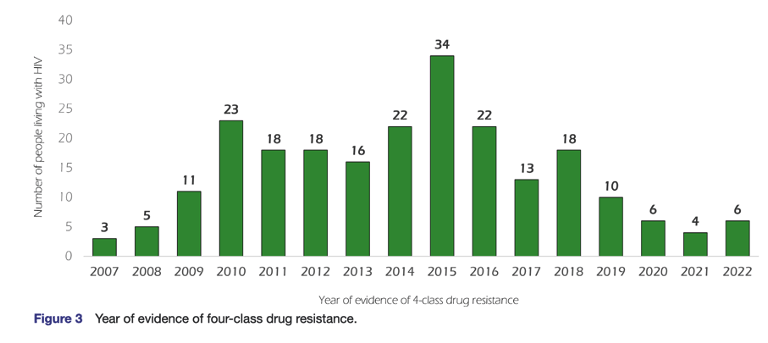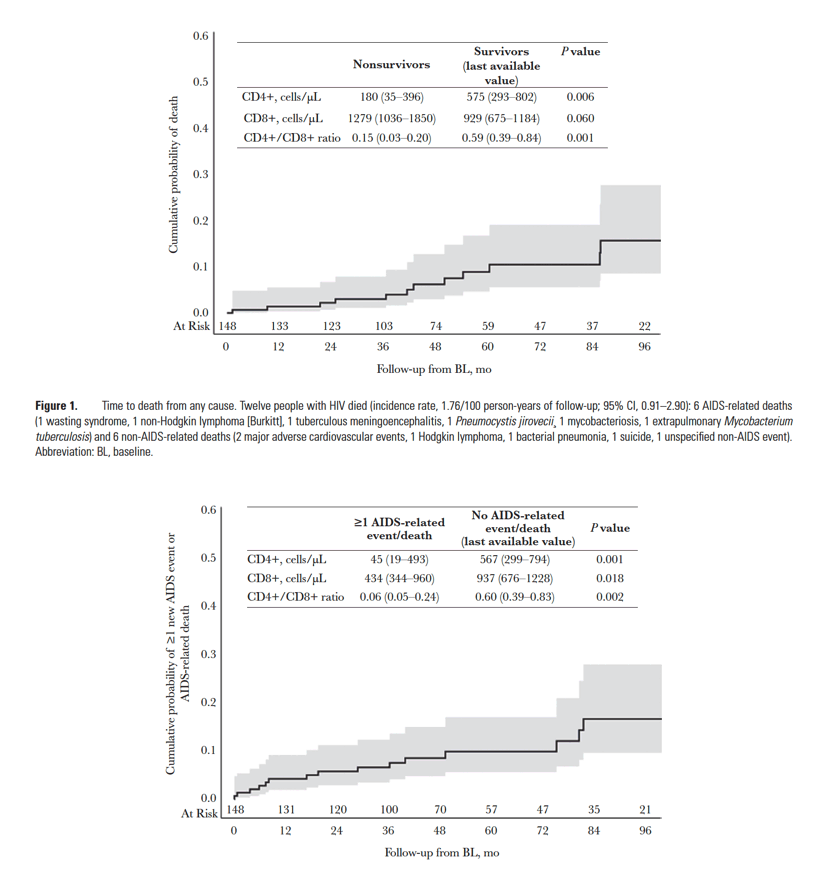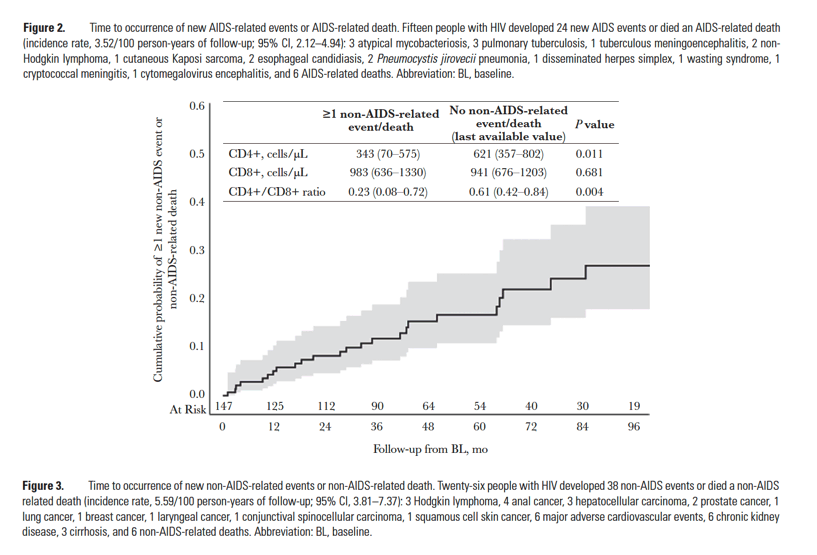| |
CD4 Non-Responders to ART; Older PWH with Limited ART Options
|
| |
| |
Download the PDF here
Download the PDF here
Download the PDF here
3 papers.
PRESTIGO Cohort reports outcomes pf PWH with 4-drug class resistance: Twelve months after baseline, 4% (95% CI, 2%-9%) of PWH were estimated to have developed an AIDS event or died an AIDS-related death, increasing to 6%, and a poor immunological profile (CD4+ cell count [IQR], 55 [20-328] vs 416 [204-629] cells/μL; P = .0001. The estimated probabilities of non-AIDS events or non-AIDS-related deaths were 5% (95% CI, 3%-10%), 8% (95% CI, 5%-15%), 12% (95% CI, 7%-19%), and 15% (95% CI, 10%-24%) at 12, 24, 36, and 48 months since BL, respectively (Figure 2); People with incident non-AIDS events/death, compared with people without non-AIDS events/death, had a similar baseline virological profile (HIV-1 RNA >50 copies/mL: 92% vs 93%; P = .994) and immunological profile (CD4+ cell count [IQR], 282 [168-501] vs 354 [170-601] cells/μL; P = .417; CD4+/CD8+ ratio [IQR], 0.26 [0.15-0.54] vs 0.37 [0.21-0.61]; P = .266). On the contrary, at the event's occurrence or last available visit, people with incident non-AIDS events or non-AIDS-related death more frequently had HIV-1 RNA >50 copies/mL (59% of people with events vs 24% of people without events; P = .002) and a poor immunological profile (Figure 3).
There is a need for New HIV Drugs with new mechanisms of action & Anti-Inflammatories, Anti-aging Drugs & Interventions including Better Clinical Care & Comorbidities Screening/Prevention.
PWH with immune non-response to ART suffer with low CD4 counts. Many older aging PWH are unable to use certain key ART classes due to drug toxicity related to the comorbidities they have, or do to drug-drug interactions.
A letter signed by community & researchers to the company developing IL-7 has been sent. The letter requests the company to consider conducting trials in PWH with suboptimal immune recovery.
IL-7 administration drives T cell-cycle entry and expansion in HIV-1 infection Single-dose rhIL-7 increased the numbers of circulating CD4+ and CD8+ T cells, predominantly of central memory phenotype. (ACTG) 5214, a phase 1 study designed to evaluate the safety, pharmacokinetic, and biologic properties of a single dose of recombinant human IL-7 (rhIL-7, CYT 0097) in persons with HIV infection. Statistically significant increases in median circulating CD4+ T-cell counts were observed in the rhIL-7 recipients compared with those in placebo recipients on day 14 (+106 vs -14 cells/μL, P = .009, Figure 2A).
1. Cohort profile: PRESTIGIO, an italian prospective registry-based cohort of people with HIV-1 resistant to reverse transcriptase, protese and integrase inhibitors

2. Inflammation burden score in multidrug-resistant HIV-1 infection
In conclusion, the current study contributes to our knowledge on the effects of HIV multidrug resistance on inflammatory burden. Actually, we provide evidence that people living with MDR HIV-1, especially when viral replication is uncontrolled, are characterized by a higher inflammation burden score compared with non-4DR-PLWH. This potentially offers the opportunity for new therapeutic options aimed at reducing excessive inflammation or reverting T-cell exhaustion, in order to improve the survival and the quality of life of this fragile population.
Results
The highest plasma biomarker concentrations were observed in viremic 4DR-PLWH, the lowest ones in non-4DR-PLWH. Endotoxin core immunoglobulin G showed an opposite trend. Among 4DR-PLWH, CD38/HLA-DR and PD-1 were more expressed on CD4+ (p = 0.019 and 0.034, respectively) and CD8+ (p = 0.002 and 0.032, respectively) cells of viremic compared to non-viremic subjects. An increased IBS was significantly associated with 4DR condition, higher values of viral load and a previous cancer diagnosis.
3. Burden of Disease in PWH Harboring a Multidrug-Resistant Virus: Data From the PRESTIGIO Registry
In PWH with 4DR virus, efforts to provide access to drugs with new mechanisms of action are also urgently needed in order to achieve undetectable HIV-RNA load, preserve the immune system, prevent clinical progression, and ultimately improve quality of life.
In this analysis, we reported that a substantial proportion of the 148 HIV-1 adults with 4DR had new clinical events or death following 4DR evidence, mainly non-AIDS-related (61%); 32% of the recorded clinical events were malignancies, and among the non-AIDS events, 45% were non-AIDS-defining malignancies. The occurrence of new clinical events or death from any cause was affected by the immunological profile at 4DR and marginally by a history of clinical events.
Another relevant finding from our study is the high incidence of non-AIDS events or non-AIDS-related death, with a rate much higher than that of the AIDS-related events.
Results
Among 148 PWH followed for a median (interquartile range) of 47 (32-84) months after 4DR evidence, 38 PWH had 62 new events or died from any cause (incidence rate, 9.12/100 person-years of follow-up; 95% CI = 6.85-11.39): 12 deaths (6 AIDS-related and 6 non-AIDS-related), 18 ADEs, 32 NADEs; 20 of the 38 NADEs (45%) of the incident clinical events were malignancies.
The 4-year cumulative incidence of death was 6% (95% CI, 3%-13%), and that of ≥1 event or death was 22% (95% CI, 16%-31%). A higher risk of new clinical events/death was more likely in PWH with previous clinical events (adjusted hazard ratio [aHR], 2.67; 95% CI, 1.07-6.67) and marginally associated with lower baseline CD4+/CD8+ ratio (aHR, 0.82; 95% CI, 0.65-1.02).
People with incident clinical events or death from any cause, compared with those without events/death, had lower baseline CD4+ cell counts (IQR) (210 [49-443] vs 436 [223-629] cells/μL; P = .003), lower baseline CD4+/CD8+ ratios (IQR) (0.20 [0.09-0.44] vs 0.45 [0.24-0.69]; P = .002), and RGSS scores (IQR) that were marginally lower (4.8 [2.5-7.5] vs 6 [4-10]; P = .072). Baseline HIV-1 RNA was >50 copies/mL in 95% of people with incident clinical events/death and in 92% of people without events/death (P = .792).
Conclusions
PWH harboring 4DR have a high burden of disease with a worrying incidence of malignancies, strongly advising for close prevention and monitoring interventions as well as access to innovative therapeutic strategies, especially in people with a history of clinical events and low CD4+/CD8+ ratio.
Twelve months after baseline, 4% (95% CI, 2%-9%) of PWH were estimated to have developed an AIDS event or died an AIDS-related death, increasing to 6% (95% CI, 3%-11%), 7% (95% CI, 4%-12%), and 9% (95% CI, 5%-15%) at 24, 36, and 48 months, respectively (Figure 1). People with incident AIDS events/death, compared with people without AIDS events/death, had a similar baseline virological profile (HIV-1 RNA >50 copies/mL: 100% vs 92%; P = .604) and a poor immunological profile (CD4+ cell count [IQR], 55 [20-328] vs 416 [204-629] cells/μL; P = .0001; CD4+/CD8+ ratio [IQR], 0.10 [0.06-0.24] vs 0.38 [0.22-0.69]; P = .0006). At the event's occurrence or last available visit, HIV-1 RNA >50 copies/mL was recorded in 70% of people with incident AIDS events/death vs 24% of people without AIDS events/death (P = .004), and a poor immunological profile was significantly associated with the occurrence of incident AIDS events or AIDS-related death (Figure 2).
The estimated probabilities of non-AIDS events or non-AIDS-related deaths were 5% (95% CI, 3%-10%), 8% (95% CI, 5%-15%), 12% (95% CI, 7%-19%), and 15% (95% CI, 10%-24%) at 12, 24, 36, and 48 months since BL, respectively (Figure 2). People with incident non-AIDS events/death, compared with people without non-AIDS events/death, had a similar baseline virological profile (HIV-1 RNA >50 copies/mL: 92% vs 93%; P = .994) and immunological profile (CD4+ cell count [IQR], 282 [168-501] vs 354 [170-601] cells/μL; P = .417; CD4+/CD8+ ratio [IQR], 0.26 [0.15-0.54] vs 0.37 [0.21-0.61]; P = .266). On the contrary, at the event's occurrence or last available visit, people with incident non-AIDS events or non-AIDS-related death more frequently had HIV-1 RNA >50 copies/mL (59% of people with events vs 24% of people without events; P = .002) and a poor immunological profile (Figure 3).


|
|
| |
| |
|
|
|